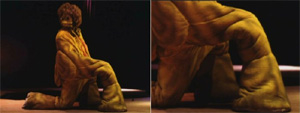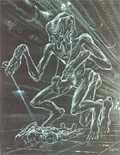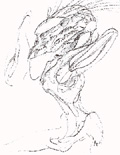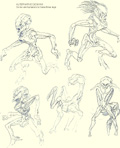|
|
 |
TREKCORE >
VOY >
EPISODES >
SCORPION
PART I &
II >
BEHIND THE SCENES >
Designing Species 8472 Part 1
 |
|
|
|
 |
The show's producers informed concept artist Steve Burg that they
wanted Species 8472 to be a real departure: a fully
computer-generated creature that was unmistakably alien. It was
time. Until then, the vast majority of Star Trek's aliens had been
distinctly humanoid. They were created with state-of-the-art makeup
but there was no escaping the fact that most races had two legs and
two arms. But at the end of the show's third season, the Visual
Effects (VFX) team was ready to try something new. Computer graphics
had advanced to the stage where they could be used to create a
virtual actor but, as VFX supervisor Ronald B. Moore explains, the
technology was far from perfect, yet it was good enough to do what
Star Trek wanted |
|
|
|
|
|
|
 |
 Ronald
B. Moore: "We'd suggested it before and
they [the producers] were a little reluctant because you make
mistakes with CG stuff sometimes. With CGI you're always on the
cusp. We're not really good at people yet. 'Jurassic Park' was
showing us that we could do things as long as they weren't too
real." Ronald
B. Moore: "We'd suggested it before and
they [the producers] were a little reluctant because you make
mistakes with CG stuff sometimes. With CGI you're always on the
cusp. We're not really good at people yet. 'Jurassic Park' was
showing us that we could do things as long as they weren't too
real." |
|
|
|
 |
The seeds had been sown earlier in Season Three in [Macrocosm],
an episode which featured giant microbe-like creatures that were
completely computer-generated (CG). The producers had been impressed
by what they saw, and wanted to take the technology further. Hence,
when they came up with an alien race who were destroying the Borg,
they made it clear they were ready to experiment with a CG alien.
Determined to take full advantage of CG technology, VFX producer Dan
Curry suggested that, if it was going to look really alien, the
creature should have three legs. |
|
|
|
 |
 Dan
Curry:
"I had always
been intrigued by the idea of a tripod creature. When I was in
graduate school, one of my thesis plays was a live-action theater
piece set in an alien prison where one of the characters was a
tripod creature, and I had come up with a special rig so that he
could move convincingly. I knew also that on Hypernauts Foundation
had done a tripod creature that was a kind of pet antelope called a
gloose. Ron Thornton had shown me a tape of the character, so I
said, 'Well, let's do something that can't be a man in a suit, so
it's really alien; let's do a tripod creature." Dan
Curry:
"I had always
been intrigued by the idea of a tripod creature. When I was in
graduate school, one of my thesis plays was a live-action theater
piece set in an alien prison where one of the characters was a
tripod creature, and I had come up with a special rig so that he
could move convincingly. I knew also that on Hypernauts Foundation
had done a tripod creature that was a kind of pet antelope called a
gloose. Ron Thornton had shown me a tape of the character, so I
said, 'Well, let's do something that can't be a man in a suit, so
it's really alien; let's do a tripod creature." |
|
|
|
|
|
|
 |
 Dan
Curry: "We had a script for a vicious alien
creature that had to be so powerful and so fearsome that it was able
to chop up and destroy the Borg. When we got the story I was
interested in creatures that had weird locomotive properties. I
guess it goes back to the old 'Fifties sci-fi book 'The Day Of The
Triffids', about these tripod plants that come to Earth and cause
trouble. Then when I was at grad. school one of my thesis projects
was to write, design and direct a play. I decided to do a science
fiction fantasy set in an alien prison. One of the characters I had
in mind was a tripod creature, so I got a friend who was an acrobat
to play it. I devised a cool cane that he could operate in his
costume so that he could walk around. After a while he was able to
convincingly move like a tripod creature. That was a comedic
creature. When this came along I thought why not do a tripod
creature. So I did some crude sketches and working with John Teska
and Steve Burg we swapped drawings back and forth until we came up
with the 8472. That was seen in the show." Dan
Curry: "We had a script for a vicious alien
creature that had to be so powerful and so fearsome that it was able
to chop up and destroy the Borg. When we got the story I was
interested in creatures that had weird locomotive properties. I
guess it goes back to the old 'Fifties sci-fi book 'The Day Of The
Triffids', about these tripod plants that come to Earth and cause
trouble. Then when I was at grad. school one of my thesis projects
was to write, design and direct a play. I decided to do a science
fiction fantasy set in an alien prison. One of the characters I had
in mind was a tripod creature, so I got a friend who was an acrobat
to play it. I devised a cool cane that he could operate in his
costume so that he could walk around. After a while he was able to
convincingly move like a tripod creature. That was a comedic
creature. When this came along I thought why not do a tripod
creature. So I did some crude sketches and working with John Teska
and Steve Burg we swapped drawings back and forth until we came up
with the 8472. That was seen in the show."

Dan Curry's tripod-creature from a thesis play |
|
|
|
|
|
|
 |
However, Dan Curry's idea was not immediately passed
on to Foundation Imaging, the company which was commissioned to
design the creature. Ron Moore explains that this was because he
does not like imposing a design on the people he works with too
early in the process.
 Ron
Moore: "We approached Ron Thornton at
Foundation and said, 'Look, here's what we're trying to do. Why
don't you have your guys draw something up, and we'll look it over.'
The way I like to work with the CG houses is to be nebulous; I don't
like to be real specific because it ties their hands in. That allows
their creative flow, so I can see it. A lot of times it'll be, 'No,
I'm sorry, let's do it this way instead.' But at least I get to see
another version. I would never presume to jump on that three-legged
thing unless it was a script point. I'll just say, 'Show me some
alien creatures.' " Ron
Moore: "We approached Ron Thornton at
Foundation and said, 'Look, here's what we're trying to do. Why
don't you have your guys draw something up, and we'll look it over.'
The way I like to work with the CG houses is to be nebulous; I don't
like to be real specific because it ties their hands in. That allows
their creative flow, so I can see it. A lot of times it'll be, 'No,
I'm sorry, let's do it this way instead.' But at least I get to see
another version. I would never presume to jump on that three-legged
thing unless it was a script point. I'll just say, 'Show me some
alien creatures.' " |
|
|
|
|
|
|
 |
Therefore, with plenty of room for latitude,
Foundation Imaging turned to concept artist Steve Burg, a veteran of
movies such as The Abyss and Contact and of several earlier
Foundation Imaging projects including Hypernauts. In fact, Steve had
designed the three-legged gloose that had stuck in Dan Curry's mind.
Steve Burg worked with Foundation Imaging's owner Ron Thornton, who
passed all of Dan Curry's and Ron Moore's comments on to him. Steve
Burg started working to some very simple guidelines.
 Steve
Burg: "The main desire was to do a creature
that was definitely not a man in a suit, just to see how that would
work out. They were still writing the script at that moment, so
there was only a very brief description. It just said, 'A great
beast of some sort blasts through the wall, kills two of the Borg
and hits Harry, knocking him out.' It said it was big, and
ferocious, and terrifying, and moved very quickly; it was 14 feet
tall at one point. That was about it. There aren't really that many
limitations on what you can accomplish. It's mostly about artistic
choices. You don't have to think about physical limitations like
with a puppet creature. I would say creatures and robots are very
much like character design for animation. You just have to try to
evoke a certain feel and create an overall impression." Steve
Burg: "The main desire was to do a creature
that was definitely not a man in a suit, just to see how that would
work out. They were still writing the script at that moment, so
there was only a very brief description. It just said, 'A great
beast of some sort blasts through the wall, kills two of the Borg
and hits Harry, knocking him out.' It said it was big, and
ferocious, and terrifying, and moved very quickly; it was 14 feet
tall at one point. That was about it. There aren't really that many
limitations on what you can accomplish. It's mostly about artistic
choices. You don't have to think about physical limitations like
with a puppet creature. I would say creatures and robots are very
much like character design for animation. You just have to try to
evoke a certain feel and create an overall impression."
|
|
|
|
|
|
|
 |
Unfortunately his first drawing did not really create
the impression the producers were looking for.
 Steve
Burg: "They thought that it was too humanlike
and too similar to the creature from Alien. I guess they felt it was
just too typical, and I have to say I agree. When you first start in
on something, you tend to use slug-in placeholders, and those tend
to he derived from other things you've done; then later it starts to
take on its own identity. It does have sort of a mantis-like feeling
and I think that kept on through, but I think there was a
miscalculation in that we began by making it too derivative, not of
Star Trek things, but of other creature designs. There are
definitely similarities between the head and the alien from
Predator. Steve
Burg: "They thought that it was too humanlike
and too similar to the creature from Alien. I guess they felt it was
just too typical, and I have to say I agree. When you first start in
on something, you tend to use slug-in placeholders, and those tend
to he derived from other things you've done; then later it starts to
take on its own identity. It does have sort of a mantis-like feeling
and I think that kept on through, but I think there was a
miscalculation in that we began by making it too derivative, not of
Star Trek things, but of other creature designs. There are
definitely similarities between the head and the alien from
Predator.
"I think it was the head they were most concerned about. They wanted
something like the alien, but they didn't want a rip-off. They
wanted something that was that distinct; something very nasty and
powerful. It also had to be intelligent. The thing about an alien,
unfortunately, is making it smart usually means making it something
we can relate to on a human level. Probably, real aliens would be so
weird that they'd be unfathomable. But this is film and television;
we have to be able to understand it fairly quickly. I always joke
that aliens are always naked; they occasionally have tools or little
gadgets. Intelligence is just something to do with the eyes. One
thing that Ron mentioned, which he may have gotten from Paramount,
was that the thing was to have practically no mouth. One way of
making it look smart is to not give it big teeth, like a
Tyrannosaurus or something. If something looks very nasty and it
doesn't have obvious claws or teeth, you figure it works on a whole
other level." |
|
|
|
|
|
|
 |
 Once
the first drawing had been rejected, Ron Thornton told Steve Burg he
should simply produce some quick sketches showing a variety of looks
they could choose from. Once
the first drawing had been rejected, Ron Thornton told Steve Burg he
should simply produce some quick sketches showing a variety of looks
they could choose from.
Steve Burg: "The next batch were just basic
silhouettes. Some have three legs; some have two legs; some of them
have a split, tripodal base, with below the knee bifurcated. I don't
think I had any real strong idea. In that situation you basically
try to do as many variations as you can and hope that one of them
will click."
|
|
|
|
|
|
|
 |
The series of drawings included several three-legged
creatures that were close to what Dan Curry was looking for. The
producers chose one of these drawings and asked him to develop it
further. This involved a fair amount of work, since the view they
had chosen showed the creature from behind, and, consequently, did
not show its face.
|
|
|
|
|
|
|
 |
Steve Burg began work by concentrating on the
creature's body. As he confronted the difficulties of the creature's
alien anatomy, it started to take on a more definite form.
 Steve
Burg: "With CG even if things don't have to
support their own weight, you still have to think about how it will
move in a general sense. The biggest problem was dealing with that
third leg. In the end it became like a human leg, but it started out
as more of a symmetrical tripod; all the legs pointed out from the
middle and the body was more centrally located. A tripod is one of
those things that sounds great, but if you have a tripod, and the
creature still has a front and back, what do you do? I think it
moved back toward something you could relate to; it became sort of a
centaur." Steve
Burg: "With CG even if things don't have to
support their own weight, you still have to think about how it will
move in a general sense. The biggest problem was dealing with that
third leg. In the end it became like a human leg, but it started out
as more of a symmetrical tripod; all the legs pointed out from the
middle and the body was more centrally located. A tripod is one of
those things that sounds great, but if you have a tripod, and the
creature still has a front and back, what do you do? I think it
moved back toward something you could relate to; it became sort of a
centaur."
 By
this stage, he was starting to develop a clear idea of what Species
8472 looked like, even if the final design was still forming with
each successive drawing. By
this stage, he was starting to develop a clear idea of what Species
8472 looked like, even if the final design was still forming with
each successive drawing.
Steve Burg: "The thing
about any of these things, it's not like it's any one moment the
design suddenly appears. It's more of a process that evolves. There
are various people who affect it. Your job is to try to capture the
quality that people are looking for in a visual. I think that once
this guy got underway he began to take on his own identity. It's
really good when that happens. It's almost like these things come
out of a fog. It's a gradual thing, but by the end it becomes its
unique self. At a certain point, something clicked and everyone
started to see what this creature was." |
|
|
|
|
|
|
|
|
<
Part 0 | Index | Part 2 > |
|
|


|
|



